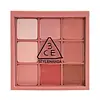What's inside
What's inside
 Key Ingredients
Key Ingredients

 Benefits
Benefits

 Concerns
Concerns

 Ingredients Side-by-side
Ingredients Side-by-side

CI 77891
Cosmetic ColorantHydrogenated Polyisobutene
EmollientDiisostearyl Malate
EmollientBis-Diglyceryl Polyacyladipate-2
EmollientSynthetic Wax
AbrasiveBis-Behenyl/Isostearyl/Phytosteryl Dimer Dilinoleyl Dimer Dilinoleate
EmollientPolyisobutene
Hydrogenated Styrene/Methylstyrene/Indene Copolymer
CI 77492
Cosmetic ColorantDiphenylsiloxy Phenyl Trimethicone
Skin ConditioningMicrocrystalline Wax
Emulsion StabilisingIsononyl Isononanoate
EmollientPolyglyceryl-3 Diisostearate
EmulsifyingCI 77491
Cosmetic ColorantAlumina
AbrasiveTriethoxycaprylylsilane
Phytosteryl Isostearate
Skin ConditioningSqualane
EmollientSodium Stearoyl Glutamate
CleansingCI 77499
Cosmetic ColorantPhenoxyethanol
PreservativeAluminum Hydroxide
EmollientBisabolol
Masking3-O-Ethyl Ascorbic Acid
Skin ConditioningTrimethylsiloxysilicate
EmollientRosmarinus Officinalis Leaf Oil
MaskingCalendula Officinalis Extract
Skin ConditioningTocopherol
AntioxidantCI 77891, Hydrogenated Polyisobutene, Diisostearyl Malate, Bis-Diglyceryl Polyacyladipate-2, Synthetic Wax, Bis-Behenyl/Isostearyl/Phytosteryl Dimer Dilinoleyl Dimer Dilinoleate, Polyisobutene, Hydrogenated Styrene/Methylstyrene/Indene Copolymer, CI 77492, Diphenylsiloxy Phenyl Trimethicone, Microcrystalline Wax, Isononyl Isononanoate, Polyglyceryl-3 Diisostearate, CI 77491, Alumina, Triethoxycaprylylsilane, Phytosteryl Isostearate, Squalane, Sodium Stearoyl Glutamate, CI 77499, Phenoxyethanol, Aluminum Hydroxide, Bisabolol, 3-O-Ethyl Ascorbic Acid, Trimethylsiloxysilicate, Rosmarinus Officinalis Leaf Oil, Calendula Officinalis Extract, Tocopherol
Talc
AbrasiveSilica
AbrasiveMica
Cosmetic ColorantHexyl Laurate
EmollientTitanium Dioxide
Cosmetic ColorantPhenyl Trimethicone
Skin ConditioningCaprylic/Capric Triglyceride
MaskingDimethicone
EmollientDiisostearyl Malate
Emollient1,2-Hexanediol
Skin ConditioningMethicone
EmollientGlyceryl Caprylate
EmollientLauroyl Lysine
Skin ConditioningAluminum Hydroxide
EmollientTriethoxycaprylylsilane
CI 77491
Cosmetic ColorantCI 77492
Cosmetic ColorantCI 77499
Cosmetic ColorantCI 19140
Cosmetic ColorantCI 73360
Cosmetic ColorantCI 77742
Cosmetic ColorantTriethylhexanoin
MaskingBoron Nitride
AbsorbentDiphenyl Dimethicone/Vinyl Diphenyl Dimethicone/Silsesquioxane Crosspolymer
Magnesium Myristate
Maltodextrin
AbsorbentCI 75470
Cosmetic ColorantCI 77007
Cosmetic ColorantCI 15850
Cosmetic ColorantTalc, Silica, Mica, Hexyl Laurate, Titanium Dioxide, Phenyl Trimethicone, Caprylic/Capric Triglyceride, Dimethicone, Diisostearyl Malate, 1,2-Hexanediol, Methicone, Glyceryl Caprylate, Lauroyl Lysine, Aluminum Hydroxide, Triethoxycaprylylsilane, CI 77491, CI 77492, CI 77499, CI 19140, CI 73360, CI 77742, Triethylhexanoin, Boron Nitride, Diphenyl Dimethicone/Vinyl Diphenyl Dimethicone/Silsesquioxane Crosspolymer, Magnesium Myristate, Maltodextrin, CI 75470, CI 77007, CI 15850
 Reviews
Reviews

Ingredients Explained
These ingredients are found in both products.
Ingredients higher up in an ingredient list are typically present in a larger amount.
Aluminum Hydroxide is a form of aluminum. It can be naturally found in nature as the mineral gibbsite. In cosmetics, Aluminum Hydroxide is used as a colorant, pH adjuster, and absorbent.
As a colorant, Aluminum Hydroxide may add opacity, or reduce the transparency. Aluminum hydroxide is contains both basic and acidic properties.
According to manufacturers, this ingredient is an emollient and humectant. This means it helps hydrate the skin.
In medicine, this ingredient is used to help relieve heartburn and help heal ulcers.
There is currently no credible scientific evidence linking aluminum hydroxide in cosmetics to increased cancer risk.
Major health organizations allow the use of aluminum hydroxide in personal care products and have not flagged it as a carcinogenic risk at typical usage levels.
Learn more about Aluminum HydroxideCi 77491 is also hydrated iron III oxide. It's sole purpose is to give a red/pink hue to products.
Iron III oxides are classified as inorganic chemicals for coloring.
Synthetically created Ci 77491 is considered safer than those naturally found. This is because the synthetically created version may contain less impurities. Iron oxides are generally non-toxic and non-allergenic.
Learn more about CI 77491Ci 77492 is also hydrated iron III oxide. It's sole purpose is to give a yellow hue to products.
Iron III oxides are classified as inorganic chemicals for coloring.
Synthetically created Ci 77492 is considered safer than those naturally found. This is because the synthetically created version may contain less impurities. Iron oxides are generally non-toxic and non-allergenic.
Learn more about CI 77492Ci 77499 is also hydrated iron III oxide. It is created from mixing red and black iron oxides. This helps give shades of darkness to a product.
Iron III oxides are classified as inorganic chemicals for coloring.
Diisostearyl Malate is an emollient and most often used in lip products. It comes from isostearyl alcohol, a fatty acid, and malic acid, an AHA.
As an emollient, Diisostearyl Malate helps create a thin film on your skin to trap moisture in. This helps keep your skin soft and smooth.
Triethoxycaprylylsilane is a silicone used to bind and stabilize ingredients.
As an emulsifier, it helps prevent ingredients from separating. This can help elongate the shelf life of products.
Triethoxycaprylylsilane is often used to coat mineral sunscreens ingredients to help give a better feel. It also helps reduce oxidative stress in sunscreens.
Learn more about Triethoxycaprylylsilane